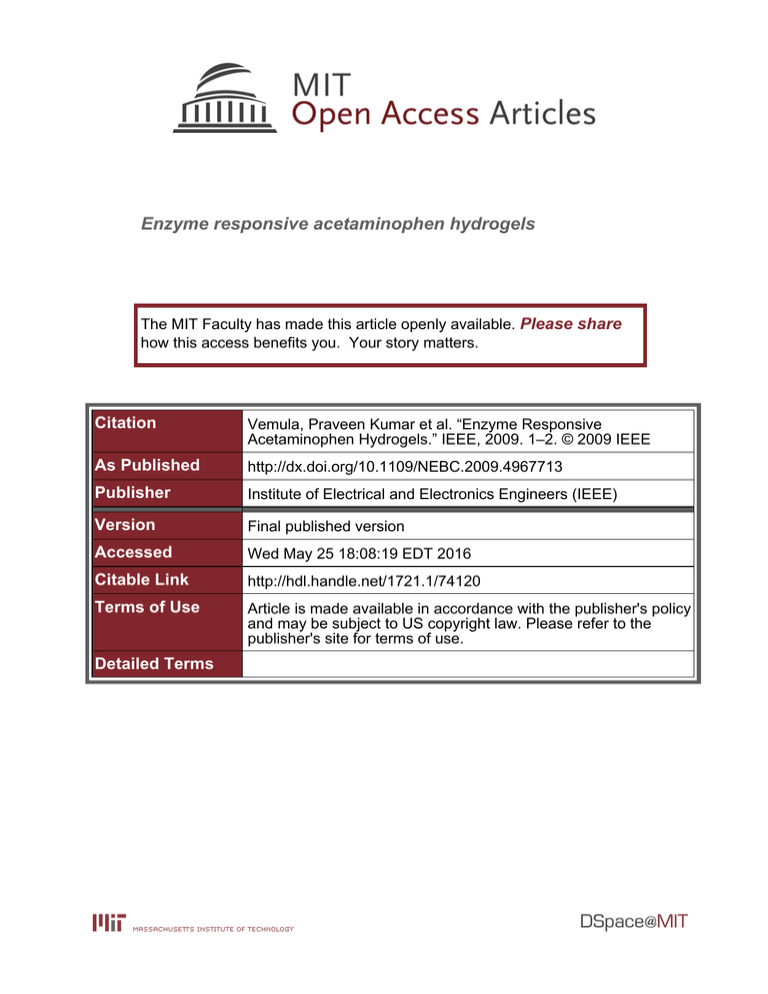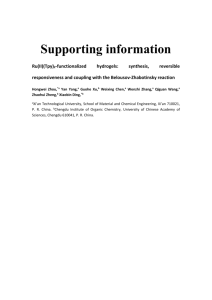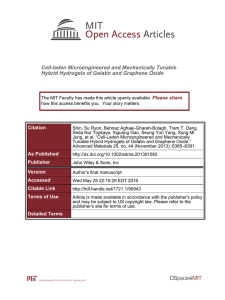Enzyme responsive acetaminophen hydrogels Please share
advertisement

Enzyme responsive acetaminophen hydrogels The MIT Faculty has made this article openly available. Please share how this access benefits you. Your story matters. Citation Vemula, Praveen Kumar et al. “Enzyme Responsive Acetaminophen Hydrogels.” IEEE, 2009. 1–2. © 2009 IEEE As Published http://dx.doi.org/10.1109/NEBC.2009.4967713 Publisher Institute of Electrical and Electronics Engineers (IEEE) Version Final published version Accessed Wed May 25 18:08:19 EDT 2016 Citable Link http://hdl.handle.net/1721.1/74120 Terms of Use Article is made available in accordance with the publisher's policy and may be subject to US copyright law. Please refer to the publisher's site for terms of use. Detailed Terms Enzyme Responsive Acetaminophen Hydrogels Praveen Kumar Vemulaa, Gregory A. Cruikshankb, George Johnb*, Jeffrey M. Karpa* aHarvard-MIT Division of Heath Sciences and Technology, Department of Medicine Brigham and Women's Hospital, Harvard Medical School, 65 Landsdowne Street, Cambridge, MA 02139, USA bDepartment of Chemistry, The City College of New York, Convent Avenue at 138th Street, New York, NY t0031 Abstract- Utilization of enzyme catalysis as a tool to disassemble self-assembled hydrogels to control the release encapsulated drug provides an opportunity to design a wide range of enzymespecific low-molecular-weight hydrogelators (LMWGs). Herein, we report a novel approach for controlled delivery of multiple drugs by an enzyme triggered hydrogel degradation mechanism. In this proof-of-concept work, we report the synthesis of LMWGs (amphiphiles) from well-known drug acetaminophen (which is known as Tylenol®), and their ability to self-assemble into nanoscale structures in aqueous solutions to form hydrogels that subsequently encapsulate a second drug such as curcumin which is a known chemopreventive hydrophobic drug. Upon enzyme triggered degradation, hydrogels showed single and double drug delivery at physiological conditions in vitro. After treating with prodrug amp hip hiles, mesenchymal stem cells (MSCs) retain their stem cell properties such as maintaining their adhesive and proliferation capacities with high viability. This new platform approach will have prospective effect on hydrogel based drug delivery research through developing drug delivery vehicles from a wide range of prod rug-based gelators. I. INTRODUCTION biocompatible fatty acid would surmount existing drawbacks. Self-assembly proved to be a powerful strategy to develop molecularly defined and functional material [I]. Hydrogels are one among them, and particularly they have been widely applied as intelligent delivery systems in controlled drug delivery [2]. A study of the literature reveals that there are only limited self-assembly based systems (low-molecularweight gelators (LMWGs) are available as opposed to polymeric hydrogels [3]. One of the major rationales for this scenario is undesired toxicity of unknown metabolites that are generated from degradation of LMWGs hydrogelators. As a consequence, here we propose a novel conceptual route to surpass possible toxicity of in situ generated fragments of LMWGs (Fig. la). The key step in this approach is selecting either clinically practiced drugs or appropriate drugs that have safe metabolic pathway as precursor molecule to generate a library of amphiphiles which can undergo self-assembly to form hydrogels. Though covalent conjugation of known-drugs to the polymer backbone is well documented, however, polymer degradation can lead to polymer fragments with heterogeneous chain lengths that may generate potential toxicity or unwanted side effects. Hence, our approach, synthesizing prodrug-based amphiphiles which can degrade in presence of an enzyme to generate parent drug and another Figure 1. a) Schematic representation of single and multiple drug delivery a) b) .. drug I l synthesis )t-o- 1 ~ H, C A OH a,ro-dircarboxVlic acid ~ DeC, DMAP. dry THF 24 h, rt amphiphiles o .Jl. ~ self·assembly H, C Prodrug·based hydrogels ~~ ~ ~~ ~~ ~~ ~ acetaminophen (Apn ) -0-o· 1"1.Jl 0 ~ h Jl, 0 ' OH n = 6 Apn·7·COOH n = 12 Apn·13·COOH ~ (with second drug encapsu lated hydrogels) 1 ,yr- , . 1 ,yr- , enzyme catalysis (hyd rogels degradation) ~. ~ , ~ " single drug" delivery " multiple drug" delivery from prodrug·based hydrogels in response to enzyme catalysis. b) Synthesis of acetaminophen based amphiphiles. Scanning and transmission electron microscope images of curcumin encapsulated hydrogels (c and d, respectively). Despite of having various stimuli such as temperature, pH and ionic strength etc to trigger drug delivery, an enzyme triggered drug delivery considered to be most safe method. In addition, often it allows the release of encapsulated therapeutics in desired locations. In this present approach we have overcome existing hurdles to develop biocompatible amphiphilic prodrugs as LMWGs to encapsulate hydrophobic drugs and subsequently release single and multiple drugs upon enzyme mediated gel degradation (Fig. la) in this investigation. To demonstrate the proof-of-concept, we N-(4choose the well-known drug Tylenol, hydroxyphenyl)acetamide, which is also known as acetaminophen (ApD), its drug activity is well studied [4,5]. APD is a common analgesic and antipyretic drug that is used for the relief of fever, headaches, and other minor aches and pains. It is remarkably safe in recommended doses and importantly its route of metabolism in humans has extensively been investigated and found to be safe. A set of amphiphiles were synthesized in a single step from APD as shown in Fig. lb. II. MATERIALS AND METHODS Prodrug-based amphiphiles (ApD-7-COOH and APD-13COOH) were synthesized using a single step esterification reaction from acetaminophen (Fig. Ib). Typically, in a round bottom flask, a ,ro-dicarboxylic acid (12 mmol) was dissolved in dry THF, to that 1.2 equivalent of DCC and catalytic amounts of DMAP was added at room temperature. After stirring for 1 hr, 4-Hydroxyacetanilide (Apn, 1.36 g, 10 mmol) was added in one lot and stirring continued for 24 hrs. After completion of the reaction, mixture was filtered to remove DCU, washed with THF. After removal of THF, slightly acidic water was added, and thrice extracted with chloroform; organic layer was dried over anhydrous Na2S04. After evaporating the solvent, the obtained crude products were purified by silica gel column chromatography using methanol:chloroform (1:9) as eluent, afforded pure products as white solid. Yields of the reactions were - 50%. III. RESULTS AND DISCUSSION Gelation abilities of Apn based amphiphilic prodrugs have been investigated thoroughly in a wide range of solvents. The amphiphile Apn-7-COOH forms excellent gels in water and other aqueous buffer solutions even in the presence of salts. In addition, Apn-7-COOH is soluble in basic solutions (PH greater than 8), on contrary it forms hydrogel in acidic and neutral pH solutions. This clearly shows that terminal carboxylic acid groups play a vital role in self-assembly through formation of a hydrogen bonding network. However, due to the longer hydrophobic chain Apn-13-COOH was sparingly soluble in water and thus additional co-solvent (5-15 v/v% of alcohol such as methanol, ethanol or isopropanol) is necessary to make the hydrogel. Hydrogels of Apn-7-COOH or Apn-13-COOH were found to encapsulate high concentrations of curcumin (up to 0.5 mmol); this observed enhanced concentration of curcumin could be due to localization of hydrophobic curcumin within the hydrophobic pockets of the hydrogen's three-dimensional network. Morphology of curcurnin encapsulated hydrogels were examined under electron microscope; SEM and TEM images (Fig. 1 c and d, respectively) showed that prodrug gels form branched or entangled fibrous/sheet-like gel networks with fiber thickness of 50-400 nm, and fiber lengths of several microns. To examine multiple (two) drug delivery (Fig. 2a), lipase was added to the curcurnin encapsulated hydrogel of Apn-7COOH (2 wt%) and kept it at 37 °C. Absorbance spectra were recorded on aliquots which were collected (after the addition of enzyme to the hydrogel) at regular intervals. Interestingly, initial aliquots did not show any absorbance peak, but aliquots collected after 4 hrs showed absorption maxima at 425 nm, which corresponds to the absorption peak of curcurnin. To determine the role of the enzyme on hydrogel degradation, similar experiments were performed by adding only buffered solution without an enzyme. As we expected curcumin encapsulated gel was still intact over a month, there was no absorbance peaks corresponding to the curcurnin were observed suggesting that the enzyme is required for gel degradation. Interestingly, increasing either the concentration of enzyme or incubation temperature to 45 °C doubled the rate of drug release. a) 4 ~ 2 III .0 1 c (5 -4hr 8 hr 12hr 16hr 20 hr 24hr 0 2~OO----3~00---400 ~~~500~ J.. (nm) C) 100..----------""C-"...,-J- - - - , ~ 75 ~ (j) <.) 50 "0 ~ <II .r: 25 "0 « 0 20 ;i 80 .~ :.0 60 100 ~ III til ~ br r :E- X I: IiII II II PBS treated :> Apn Apn·7·COOH I X [ 1 PBS treated Apn c::J Apn·7·COOH 40 20 0 d) 30 'b T"" CJ I :?:!. 20 ~ 15 (j) ~--- 25 . :::::--- - - - - - Apn _ _ PBS treated <.) ~- Apn ·7·C OOH '0 0 0 2 4 days 6 8 Figure 2. a) Absorption spectra curcumin released from degraded hydrogel of Apn-7-COOH at different time points. Examining the effect of Apn-7COOH prodrug on MSCs cellar properties such as b) viability, c) adhesion and d) proliferation. To test the cytocompatibility of prodrug-based amphiphiles, and their effect on cell characteristics such as viability, proliferation, and adhesion; a series of experiments were performed with MSCs. In these experiments unmodified drug (Apn) and modified drug Apn-7-COOH were examined with trypan blue assay. The presented results (Fig. 2b) suggest that there was no significant decrease in the viability of the MSCs after 48 hours incubation with prodrug-based amphiphile. These results clearly show that Apn-derived prodrug amphiphiles did not induce cell toxicity. In addition, data showed in Fig. 2 c and d clearly suggesting that Apn-7COOH amphiphile did not affect the inherent cell properties such as adhesion and ability to proliferate. IV. CONCLUSIONS In conclusion, Apn-based amphiphilic prodrugs have showed excellent hydrogelation ability and could encapsulate curcumin. Delivery of single and multiple drugs has been achieved upon enzyme-triggered gel degradation at physiological condition. Newly synthesized prodrugs were highly cytocompatible in nature. REFERENCES [I) (2) (3) (4) (5) (6) G. M. Whitesides, M. Boncheva, Proc. Nat!. Acad. Sci. U. S.A. 2002, 99, 4769-4774. Y. Qiu, K. Park, Adv. Drug. Deliv. Rev. 2001,53,321-329. G. Wang, A. D. Hamilton, Chem. Commun. 2003, 310-311. Z. Cheng, L. Ou, X. Zhou, F. Li, X. Jia, Y. Zhang, X. Liu, Y. Li, C. A. Ward, L. G. Melo, D. Kong, Mol. Ther. 2008, 16, 571-579. L. A. Pina, M. Sandrini, G. Vitale, Eur. J. Pharmacal. 1996,308,31-40. O. Boutaud, D. M. Aronoff, J. H. Richardson, L. J. Mamett, J. A. Oates, Proc. Nat!. Acad. Sci. U.S.A. 2002, 99, 7130-7135 .




